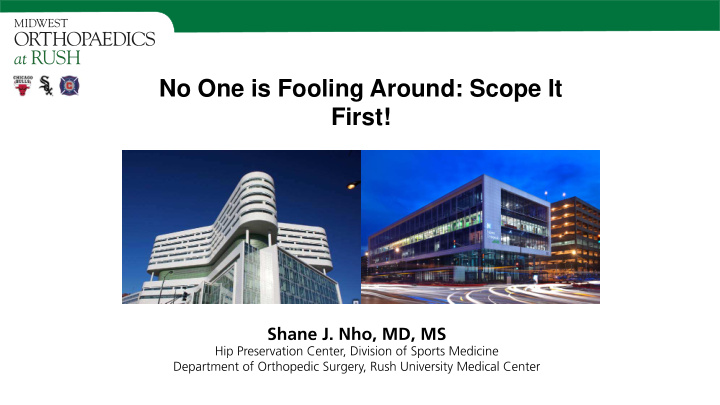



No One is Fooling Around: Scope It First!
I (and/or my co-authors) have something to disclose. Detailed disclosure information is available via: Printed Final Agenda AAOS Orthopaedic Disclosure Program on the AAOS website at http://www.aaos.org/disclosure
What is Borderline Dysplasia? • Most describe borderline dysplasia using radiographic parameters • LCEA between 18-25° • Tönnis angle between 10-14° • There are dysplasia variants that may push you to consider open surgery • Femoral sided deformities • Acetabular orientation • Treatment decision making is complex as there may be overlap between dysplasia and FAIS
Which Is It? Dysplasia FAIS
Is There a Role for Isolated Hip Arthroscopy in Dysplasia? Parvizi et al. J Arthroplasty 2009. • 36 Hips for dysplasia (DDH in 30; Retroversion in 6) and FAI underwent HA labral debridement and osteoplasty • Improvement at 6 wks then deteriorated over time • 13 Femoral head migration • 14 Accelerated OA Mei-Dan et al. Arthroscopy 2012.
Is There a Role for Isolated Hip Arthroscopy in Dysplasia? Matsuda at el. Arthroscopy 2012. • 2 cases of rapid acceleration of hip OA Mei-Dan et al. Catastrophic Failure in Hip Arthroscopy Due to Iatrogenic Instability: Can Partial Division of Lig Teres and Iliofemoral Ligament Cause Subluxation? Arthroscopy 2012. Matsuda et al. Arthroscopy 2012.
• 48 patients with LCEA < 25° with mean 27 months s/p labral debridement, chondroplasty / MFX • 16 Dysplasia (< 20°) MHHS 57 83 • • 32 Borderline (20-25°) MHHS 50 77 • • 2 Converted THA • Dysplasia is not a contraindication for hip arthroscopy Byrd et al. Arthroscopy 2003.
Hip Arthroscopy in Dysplasia Dysplasia Cohort FAIS Cohort 231 Cases with 52% Female 88 Cases with 71% Female • LCEA 20.8° (range, 8.7°-24.5°) Outcomes • Tonnis Angle 11° (range, 0°-22.2°) • MHHS 88.4 Outcomes • 81.2% Good to Excellent • MHHS 81.3 • 60.9% Good to Excellent • Labral and capsular repair Predictors of Failure (PAO/THA or MHHS < 70): Grade 4 chondral • MHHS 85 defects • 73% Good to Excellent Larson et al. AJSM 2015.
Borderline Dysplasia Borderline dysplasia • Domb et al. AJSM 2013. • 26 patients with CEA 22.2° (range, 18-25°) underwent HA with labral repair and capsular plication • 77% (17/22) G/E outcome 14% (3/22) Tonnis 0 1 • • 9% (2/22) Revision
Outcomes After Hip Arthroscopy for Borderline Dysplasia • HSS Experience with 55 cases • Rush Experience with 36 cases hip arthroscopy and capsular hip arthroscopy and capsular closure for BD with 31 months closure for BD with 2.6 yr follow follow up (Nawabi et al. AJSM up (Cvetanovich et al. AJSM 2016) 2017) LCEA Tonnis Alpha LCEA Tonnis Alpha BD 22.4° 6.3° 66.3° BD 23.4° N/A 60.3° Control 31.0° 2.2° 61.7° Control 32.5° N/A 62.2° • Significant improvement in all • Significant improvement in all PRO for both groups PRO for both groups • 2 Revision Hip Arthroscopy • 1 Revision Hip Arthroscopy
Male with Borderline Dysplasia 17 yr old elite level hockey goalie Physical Exam with bilateral hip pain • ROM • Flexion 0 – 100° • ER 30° • Plays in the butterfly stance • IR 10° • Attempted therapy but • Positive FADIR symptoms not improved • Full strength
CAM Deformities Right Alpha 62° Left Alpha 69°
Right Hip Pre-Op Post-Op
Left Hip Pre-Op Post-Op
Female with Borderline Dysplasia • 15 yr old HS soccer player with history of dysplasia s/p Pavlik harness as an infant complains of right anterior hip pain. • C sign • Pain worse running and kicking • Pain worse with sitting, standing, walking, shoes and socks, in and out of car • Clicking and popping
Female with Borderline Dysplasia
Female with Borderline Dysplasia
Female with Borderline Dysplasia
Female with Borderline Dysplasia
Female with Borderline Dysplasia
Female with Borderline Dysplasia
Female with Borderline Dysplasia
Female with Borderline Dysplasia
Scope First! • Based on the best evidence • Use caution when the case may available, using contemporary have multiple features of dysplasia techniques in hip arthroscopy • LCEA < 18° (labral refixation and capsular • Tonnis angle > 15° plication), borderline dysplasia • Break in Shenton’s Line (LCEA > 18°, Tonnis < 10°) hips • Femoral head extrusion/lateralization should undergo hip arthroscopy in • Femoral valgus / anteversion the majority of cases. • Beighton score > 4 • Males with large femoral head/CAM • Refer to an open hip preservation with low volume acetabulum surgeon for cases concerning of • Females with hypermobility dyplasia
Shane J. Nho, MD, MS Shane.nho@rushortho.com
Recommend
More recommend